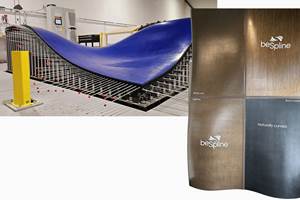Unweighting a crane to increase payload limit
Rethinking a crane stinger with carbon fiber for a more “uplifting experience.”
The payload capacity of a crane depends on the strength and stiffness of the materials used to make the arm. It also depends, ironically, on the arm’s weight. That is, the greater the arm’s weight, the less payload it can bear. Conversely, you can increase the payload capacity of the crane by reducing the mass of its arm. In other words, the crane arm is an ideal application for composites.
The Manitowoc Co., a crane manufacturer located in Shady Grove, PA, US, recognized this advantage and decided to target the stinger or fly jib — the final segment of an articulating crane arm — on one of its truck-mounted cranes, replacing the traditional 24-ft (7.3m) steel structure with one of carbon fiber composite.
Sammy Munuswamy, senior principal engineer, global engineering and innovation at Manitowoc, says the company is “in the business of building lifting experiences for our customers around the world.” And a quality “lifting experience,” in Manitowoc’s view, should be one where
 the tool (crane) facilitates the jobs to be done at a variety of jobsite environments, including buildings, roadsides, heavy construction sites and more. “Cranes are getting lighter,” Munuswamy says, “and we need materials to meet that expectation. The stinger section was identified as an ideal candidate for conversion into a carbon fiber light-weight structure since the outermost crane arm components generate the highest bending moments on the crane. Therefore, reducing weight in such members brings the most tangible benefits.”
The stinger was developed by Manitowoc in collaboration with Riba Composites Srl (Faenza, Italy), which has extensive experience designing and manufacturing large composite structures. Munuswamy says one of the challenges the company faced was the reality that cranes, as a cost-sensitive, low-volume product, do not allow for expensively engineered structures. In addition, the composite stinger is a drop-in replacement for its predecessor.
Because the carbon fiber stinger works as a component retrofit compatible with existing cranes, Riba's engineers exploited all the available design space, maximizing the moment of inertia and the geometric properties of the stinger. The result is a hybrid structure where steel and composite match to take advantage of the specific properties of each material. The junction between steel and composite relies on bonding and bolts, which allow an effiient solution.
Andrea Bedeschi, general manager at Riba, says the composite stinger is hand-laid, using carbon fiber prepreg and autoclave cure. The carbon fiber, standard-modulus 12K and 24K tow, is supplied by Mitsubishi Chemical Carbon Fiber & Composites Inc.. The resin is a toughened epoxy. Riba performed NDT evaluation of the stinger; physical load, stability and structural performance testing was done by Manitowoc.
The composite stinger is 35% lighter than its steel predecessor and, says Munuswamy, increases payload capacity 12-15% more than the steel version in some specific boom configurations. The composite stinger also is more expensive than its steel predecessor, but Munuswamy says this is more than compensated for by increased jobsite efficiency and transportability.
Will Manitowoc expand carbon fiber use to other crane components? “This [the stinger] is leading us in that direction,” Munuswamy says. “The stinger was the first step.”
Related Content
Pultron Composites GFRP rebar addresses facility, marina project challenges
The company’s Mateenbar GFRP rebar has led to more durable solutions for production of a new medical research center, and to improve structures regularly exposed to harsh marine conditions.
Read MoreBrainDrip scales up composite technology to meet current, future energy infrastructure needs
Next-generation composite pipe development with embedded, AI-enhanced health monitoring will modernize new and aging pipelines globally.
Read MorePlant tour: BeSpline/Addcomp, Sherbrooke, QC, Canada
Composites automation specialist increases access to next-gen technologies, including novel AFP systems and unique 3D parts using adaptive molds.
Read MoreGFRP Tech launches South African facility for GFRP rebar production
Said to be the first of its kind in this region, GFRP Tech will manufacture, test and supply flagship EnviraBar and EnviraMesh products to support South Africa’s infrastructure modernization.
Read MoreRead Next
Cutting 100 pounds, certification time for the X-59 nose cone
Swift Engineering used HyperX software to remove 100 pounds from 38-foot graphite/epoxy cored nose cone for X-59 supersonic aircraft.
Read MoreNext-gen fan blades: Hybrid twin RTM, printed sensors, laser shock disassembly
MORPHO project demonstrates blade with 20% faster RTM cure cycle, uses AI-based monitoring for improved maintenance/life cycle management and proves laser shock disassembly for recycling.
Read MoreUltrasonic welding for in-space manufacturing of CFRTP
Agile Ultrasonics and NASA trial robotic-compatible carbon fiber-reinforced thermoplastic ultrasonic welding technology for space structures.
Read More











